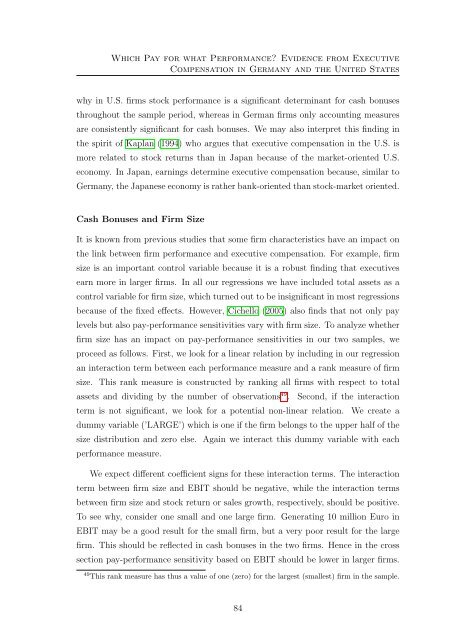Three Essays on Executive Compensation - KOPS - Universität ...
Three Essays on Executive Compensation - KOPS - Universität ...
Three Essays on Executive Compensation - KOPS - Universität ...
You also want an ePaper? Increase the reach of your titles
YUMPU automatically turns print PDFs into web optimized ePapers that Google loves.
Which Pay for what Performance? Evidence from <strong>Executive</strong><br />
Compensati<strong>on</strong> in Germany and the United States<br />
why in U.S. firms stock performance is a significant determinant for cash b<strong>on</strong>uses<br />
throughout the sample period, whereas in German firms <strong>on</strong>ly accounting measures<br />
are c<strong>on</strong>sistently significant for cash b<strong>on</strong>uses. We may also interpret this finding in<br />
the spirit of Kaplan (1994) who argues that executive compensati<strong>on</strong> in the U.S. is<br />
more related to stock returns than in Japan because of the market-oriented U.S.<br />
ec<strong>on</strong>omy. In Japan, earnings determine executive compensati<strong>on</strong> because, similar to<br />
Germany, the Japanese ec<strong>on</strong>omy is rather bank-oriented than stock-market oriented.<br />
Cash B<strong>on</strong>uses and Firm Size<br />
It is known from previous studies that some firm characteristics have an impact <strong>on</strong><br />
the link between firm performance and executive compensati<strong>on</strong>. For example, firm<br />
size is an important c<strong>on</strong>trol variable because it is a robust finding that executives<br />
earn more in larger firms. In all our regressi<strong>on</strong>s we have included total assets as a<br />
c<strong>on</strong>trol variable for firm size, which turned out to be insignificant in most regressi<strong>on</strong>s<br />
because of the fixed effects. However, Cichello (2005) also finds that not <strong>on</strong>ly pay<br />
levels but also pay-performance sensitivities vary with firm size. To analyze whether<br />
firm size has an impact <strong>on</strong> pay-performance sensitivities in our two samples, we<br />
proceed as follows. First, we look for a linear relati<strong>on</strong> by including in our regressi<strong>on</strong><br />
an interacti<strong>on</strong> term between each performance measure and a rank measure of firm<br />
size. This rank measure is c<strong>on</strong>structed by ranking all firms with respect to total<br />
assets and dividing by the number of observati<strong>on</strong>s 49 . Sec<strong>on</strong>d, if the interacti<strong>on</strong><br />
term is not significant, we look for a potential n<strong>on</strong>-linear relati<strong>on</strong>. We create a<br />
dummy variable (’LARGE’) which is <strong>on</strong>e if the firm bel<strong>on</strong>gs to the upper half of the<br />
size distributi<strong>on</strong> and zero else. Again we interact this dummy variable with each<br />
performance measure.<br />
We expect different coefficient signs for these interacti<strong>on</strong> terms. The interacti<strong>on</strong><br />
term between firm size and EBIT should be negative, while the interacti<strong>on</strong> terms<br />
between firm size and stock return or sales growth, respectively, should be positive.<br />
To see why, c<strong>on</strong>sider <strong>on</strong>e small and <strong>on</strong>e large firm. Generating 10 milli<strong>on</strong> Euro in<br />
EBIT may be a good result for the small firm, but a very poor result for the large<br />
firm. This should be reflected in cash b<strong>on</strong>uses in the two firms. Hence in the cross<br />
secti<strong>on</strong> pay-performance sensitivity based <strong>on</strong> EBIT should be lower in larger firms.<br />
49 This rank measure has thus a value of <strong>on</strong>e (zero) for the largest (smallest) firm in the sample.<br />
84
















